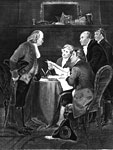At a Glance
Topics
Website
Features
Duration
Grade(s)
Lesson Format
Download
Prequel to Independence
Students view primary and secondary sources that represent events leading up to the publication of the Declaration of Independence and place them in chronological order.
Review

Teaching the events leading up to the Declaration of Independence is routine in many American history classrooms. This lesson consists of a brief sequencing activity followed by a written assessment and is a good activity to use in conjunction with other activities on this topic. Students view a collection of 10 historical documents representing events leading up to the Declaration of Independence. Each document includes an image of the original document and brief explanatory details. After putting the documents in their proper sequence, students are prompted to write one to three paragraphs describing the sequence of events leading to the publication of the Declaration of Independence, using the documents they have just sequenced as specific examples.
While the activity is simple and short, it can help to lay the foundation for a lesson on contextualization, as students place documents in chronological order and see them in the context of surrounding events. Additionally, this lesson provides an excellent opportunity to analyze the nature of cause and effect and teachers could augment the lesson by having students explain how specific events are related to one another as well as to the Declaration of Independence.
This lesson is one of a large collection of similar activities in which students engage with historical documents. Teachers can register with the website for free and create their own activities using a large searchable database of primary and secondary sources.
Notes
Students can complete this activity on the website itself, and email the written assessment to the teacher through the website, or teachers may print the documents and have students complete the activity on paper.
| Field | Criteria | Comments | ||
|---|---|---|---|---|
| Historical Content | Is historically accurate? | Yes |
||
| Includes historical background? | Yes |
|||
| Requires students to read and write? | Yes |
|||
| Analytic Thinking | Requires students to analyze or construct interpretations using evidence? | No |
||
| Requires close reading and attention to source information? | No |
|||
| Scaffolding | Is appropriate for stated audience? | Yes |
||
| Includes materials and strategies for scaffolding and supporting student thinking? | No |
|||
| Lesson Structure | Includes assessment criteria and strategies that focus on historical understanding? | Yes |
||
| Defines clear learning goals and progresses logically? | Yes |
|||
| Includes clear directions and is realistic in normal classroom settings? | Yes |
|||